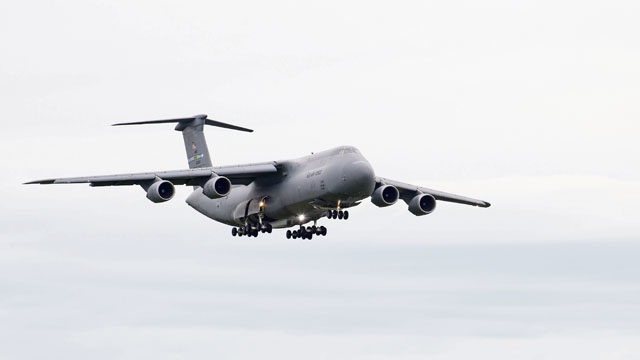
Airmen assigned to Ramstein’s 521st Air Mobility Operations Wing quickly and safely responded to a C-5 Galaxy landing incident May 23 at Naval Station Rota, Spain, assuring minimal disruption to the airfield’s operations in support of Rapid Global Mobility.
During approach, the C-5’s nose landing gear would not extend. The aircrew was able to land safely. However, after the crew and passengers were off the plane, the large aircraft remained stuck on the runway – essentially, shutting it down on a day when more than double the average air traffic was transiting Rota and several critically important missions hung in the balance.
“There were a handful of jets on the ramp that were presidential support missions departing the next day,” said Col. Eric Hook, 521st Air Mobility Operations Group commander. “It was absolutely crucial to reopen the runway. Not only to support the presidential mission, but also aircraft, cargo and passengers transiting to European Command, Central Command and even down to Africa Command.”
While the cause of the incident is still under investigation, the team from the 725th Air Mobility Squadron had the diverse experience and training necessary to respond. Airmen assigned to Naval Station Rota consistently work with joint and coalition partners, which allowed them to collaborate for the situation.
“We had just table topped this [type of scenario] with our Navy counterparts about a month before, so we knew what roles we would all have in an aircraft recovery along with what equipment we had,” said Master Sgt. Kory Newgard, a production superintendent for the 725 AMS. “They were super responsive and supportive throughout the event.”
With time ticking, Marcus Carrion, 725 AMS technical advisor, assembled a team of maintainers based on areas of special expertise to remove the aircraft from the runway.
“We had one guy who is really good at using aircraft jacks, and one who is good at towing,” said Carrion. “We assembled the best of the best.”
That team included Master Sgt. Michael Bartlett, a 725 AMS production superintendent, who reviewed the technical manuals and suggested they use a process called kneeling. Kneeling uses hydraulics and the aircraft’s weight to raise or lower the body, tail or in this case, the nose of the C-5. Using this method instead of aircraft jacks or airbags saved up to twelve hours from the usual expected recovery time that day.
“One of the most important things to do during a situation like this is be very decisive because if not, you burn up a lot of time, and that’s one thing we didn’t have,” said Carrion. “The success of this whole recovery was because of that kneeling procedure and our team members who carried it out flawlessly.”
While time was of the essence, safety was a top concern for the team.
“This team did a great job of making safety a top priority and for making the recovery happen in a short time,” said Newgard. “They put Rota on the map for having some top-notch maintainers.”
While some focused on removing the C-5 from the runway, others focused on continuing the daily mission. The squadron relies on experience and training to expeditiously transport mission-essential equipment and personnel to combatant commanders worldwide.
Because of the teamwork, the safety focus, and the dedication to excellence displayed by the mobility Airmen, the airfield returned to a mission capable status in just 12 hours.
“They had the right maintainers to go out and take care of that jet,” said Hook, the group commander. “They were able to get it safe, secure, and in a configuration where they could lower the gear and tow it off of the runway in an incredibly short amount of time.”
Hook said the team demonstrated the passion enroute Airmen have to work safely and quickly, while minimizing downtime on airfields and enabling AMC aircraft to rapidly deliver cargo and personnel to combatant commanders worldwide.
“I am an AMC Airman and I’m extremely proud of what the men and women here in the fixed enroute do,” said Hook. “The Air Mobility system continues to move along and through our locations to benefit the joint warfighter downrange and it’s because of our Mobility Airmen.”


